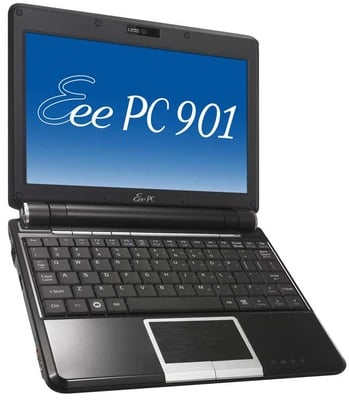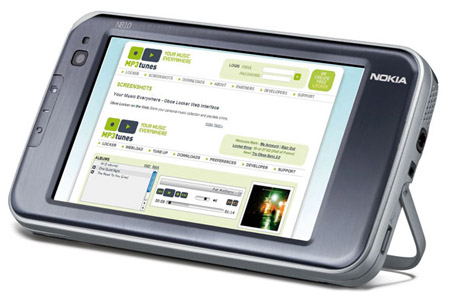Original URL: https://www.theregister.com/2008/07/02/internet_devices_os/
What's going to power Small, Cheap Computers?
Atoms, dragons and Windows?
Posted in Channel, 2nd July 2008 09:53 GMT
Between the mobile phone and the laptop computer a new class of device is emerging, and control of it is up for grabs - it appears the next battle will be fought between seasoned industry scrappers and young bloods over the 'armtop'.
Mobile phones are becoming more and more like computers - link one to a Bluetooth keyboard and an external VDU, and it can offer an approximation of a desktop computing experience. It might be a pale imitation, but the important thing is that the attempt can be made.
Meanwhile, laptop computers are getting smaller and cheaper, partly because even Windows struggles to consume the processing power available in today's top-end machines - thus reducing the need to buy new ones - and partly because the manufacturers are trying to expand the market.

Asus' Eee PC 901: Atom based, XP-friendly
Charles Dunstone of Carphone Warehouse compared home computer ownership to the telephone of 30 years ago, when each house had one handset, generally in the hallway or kitchen, and there was no such thing as a private phone call. Transferring that analogy to computing, there should be an explosion in mobile computing in the home - though what kind of computing experience those devices will offer is open to debate.
Windows XP has been trying to squeeze itself into these new devices, and Microsoft has extended the life of the OS as that market expands - no one is pretending that Windows Vista is ready for the armtop. But Windows is expensive, so many manufacturers are using flavours of Linux as a cheaper alternative that provides all the functionality their users need.
XP might seem a strange choice for mobile devices, but it has one important ally - Intel. Intel's new Atom processor, a low-power chip compatible with their x86 platform, will run Windows XP, and no doubt will find itself in many small laptops and computing devices including set-top boxes and their ilk. But in the mobile arena the dominant chip architecture is ARM.
ARM is a licensed core to which manufacturers can add their own capabilities, or choose to develop their own implementations that recognise the ARM instruction set. ARM-based processors completely dominate the mobile computing sphere - around 90 per cent of mobile phones, including the iPhone, pack at least one ARM processor.
Atom-based devices are emerging now, but comparing power consumption is difficult and both sides can offer statistics to argue their case. It seems likely that ARM will continue to offer better battery life, even with the vast improvements Intel has put into the Atom, but Atom will likely scale up more easily and thus be able to run Windows XP at a usable speed.
With Microsoft and Intel both pushing for x86 compatibility, and thus Windows XP on mobile devices, they might seem unstoppable. Except that Microsoft isn't pushing that way at all.
Unlike XP, Windows Mobile doesn't need x86 compatibility. In fact, the latest versions have dropped support for what they consider legacy platforms, and Windows Mobile is becoming an ARM-only product.
Right now Windows Mobile is aimed at mobile phones, though Microsoft has aspirations for it to drive everything below the full-blown desktop replacement. Jason Longridge, UK Mobility Business Manager at Microsoft, told us the only reason for using desktop Windows was "if they [the user] has got a legacy application that requires Vista or XP". Other than that he expects Windows Mobile to fulfil their every need, and on an ARM processing core.
ARM chips have their own super-power backing in the form of Qualcomm, whose Snapdragon processor is coming out later this year. It will apparently provide comparable processing power with Intel's Atom, while consuming even less power.

Nokia's N810: Linux all the way
Qualcomm isn't expecting to use Windows mobile on Pocketable Computing Devices (what Intel calls a "Mobile Internet Device", though Qualcomm also has a bigger "Mobile Computing Device"). The company is sold on the Linux dream: "The only thing you can't do [with Linux] is bring your applications with you," Manjit Gill, Qualcomm's director of product management, told us. However, surprisingly often that's exactly what people want to do.
One player with no aspirations towards the middle ground is Symbian, which prefers the mid to low-end phone market and has no ambition to be all things to all men. Even Nokia, proud owner of the soon-to-be-open-sourced OS, doesn't use Symbian on its Internet Tablet device - which will soon become a range of Linux-based devices aimed squarely at this middle ground.
Intel contends that surfing the web isn't possible without x86 applications such as Macromedia's Flash, but that's belied by the availability of Flash on ARM, along with just about every other handy bit of software. The reality is that all the popular technologies will be available on the next generation of internet-capable devices, regardless of the processor they use or the operating system they run.
Intel's Atom will win wherever Windows XP makes sense, but as long as punters know that XP is for desktops they'll be happy to take alternatives on mobile devices, especially as they move further away from the recognisable laptop form factor. So expect to see Intel pushing Windows XP as the only platform for mobile surfing, while everyone else looks elsewhere. ®